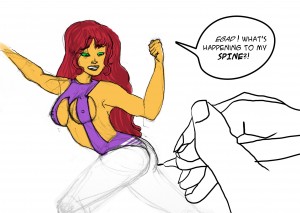Sex and Superheroines: Why DC’s “New 52” Relaunch Won’t Connect With Women
The Starfire on Cartoon Network’s Teen Titans was someone I looked up to. She was a loyal and loving friend to her teammates. She ate pizza, got zits, and kicked butt with her emotionally-fueled alien-power energy bolts. I searched her on Wikipedia one day when I was middle school. What I found seemed to be a picture of a bright orange stripper with extremely pointy nipples.
What I had not known was that Teen Titans was a superhero show based on the DC Comics universe but targeted at younger audiences. The Wikipedia image was from a comic book from the 80’s. I took one message away from that unfortunate search: DC Comics are porn.
In 2011, the 75-year-old franchise announced a relaunch of every one of their existing series in an attempt to attract a new readership. Starfire occupies a completely different role in the revamped Red Hood and the Outlaws. She casually offers sex to her male teammates. She forgets the names of her hookups. She is usually in a bikini. She strikes a pose for the viewer in every panel: boobs and butt pointed straight at us.
To be fair, Starfire was always written as a “sexually liberated” character, because on her home planet, Tamaran, the people “offer their love to many people, always emotionally, and sometimes physically” (Hudson). Of course the writers of the Teen Titans chose not to include this characterization in their cartoon. Instead, they made Starfire the friendly, caring alien girl who goes out of her way to be kind to others. As Teen Titans’ viewership of two million people grew up, you would think DC would take some hints from the success of the kid-friendly series. But the Starfire we see in the revamp shows us an emotionally detached barbie doll. She is not sexually liberated as she was initially portrayed to be. She is a sex toy. Her primary role in the comic is eye candy.
Starfire is not the only character to receive a revamp for men and by men. The cover of Catwoman’s new series sparked controversy with its improbable anatomy and obvious exploitation of sex appeal. Catwoman is approximately 80% boobs and butt in this image. The first panel of the first page strikes a more ridiculous percentage. 100% boobs. 0% face. As Andrew Wheeler of Bleeding Cool writes, “This is consciously and conspicuously an exploitation comic. This is a comic that emphatically sensationalizes sex to stir up its audience” (Wheeler).
The final scene of Catwoman #1 is a full-page spread of her actually having sex with Batman. And of course it’s okay for Catwoman and any other superheroine to have sex, but Catwoman’s liberated sexuality is not why we’re being asked to look at her being penetrated by a man only 50% in a costume. As Laura Hudson of Comics Alliance writes, “What does it accomplish or tell us about the characters that would have been lost if that page had been omitted? The answer is nothing. They just wanted to see Catwoman and Batman bang on a roof” (Hudson).
DC gave themselves an opportunity to completely change the way their comics are marketed to women and utterly screwed it up. Why?
At 2011‘s San Diego Comic Con, there was a public outcry over the fact that the percentage of DC comic book creators that are actually female dropped from 12% to 1% as the company prepared for the reboot. Elliot Brown, the creator of a petition to get DC to do something about this ratio, said “there are hundreds of talented, available women who would jump at the chance to work on comics – many of whom have experience writing, drawing, creating and editing superhero comics from the Big Two [Marvel and DC], but haven’t been hired full-time because of the ‘old boys’ club’ attitude held by many senior members” (Flood).
Since then, Jim Lee and Dan DiDio, co-publishers of DC, have publicly apologized for the statistics, assuring women that our readership demographic has not been forgotten. “We’re committed to telling diverse stories with a diverse point of view. We want these adventures to resonate in the real world, reflecting the experiences of our diverse readership. Can we improve on that? We always can—and aim to,” they wrote in a blog post (Lee and DiDio). They have since hired several more female writers and artists, but one year later the percentage of female creators remains far below any statistic to be proud of (Hanley).
Women like me deserve to be able to delve into the wonderful world of comic books. I was scared away from them at an early age and so far I have been given little reason to give DC a second chance. The reboots are still in their first issues, and DC has time to respond to its critics and get its act together. Even disregarding its artists’ ignorance concerning female body types, breast physics, and anatomy, its writers’ treatment of female characters as sexual beings leaves a lot to be desired.
Works Cited
Flood, Alison. “DC Comics Promises to Hire More Women after Reader Backlash.” The Guardian. Guardian News and Media, 01 Aug. 2011. Web. 01 Nov. 2012. <http://www.guardian.co.uk/books/2011/aug/01/dc-comics-women-writers-creators>.
Hanley, Tim. “Gendercrunching August 2012.” Bleeding Cool. BleedingCool.com, 30 Oct. 2012. Web. 01 Nov. 2012. <http://www.bleedingcool.com/2012/10/30/gendercrunching-august-2012/>.
Hudson, Laura. “The Big Sexy Problem with Superheroines and Their ‘Liberated Sexuality'” Comics Alliance. AOL, 22 Sept. 2011. Web. 01 Nov. 2012. <http://www.comicsalliance.com/2011/09/22/starfire-catwoman-sex-superheroine/>.
Lee, Dan, and Jim DiDio. “We Hear You.” DC Comics. DC Entertainment, 29 July 2011. Web. 01 Nov. 2012. <http://www.dccomics.com/blog/2011/07/29/we-hear-you>.
Wheeler, Andrew. “No More Mutants: 52 Problems.” Bleeding Cool. BleedingCool.com, 22 Sept. 2011. Web. 01 Nov. 2012. <http://www.bleedingcool.com/2011/09/22/no-more-mutants-52-problems-by-andrew-wheeler/>.

![[in]Visible Magazine](https://community.scrippscollege.edu/invisible/wp-content/uploads/sites/5/2011/04/Invisible-Masthead-2011-Spring1.png)








No comments yet... Be the first to leave a reply!